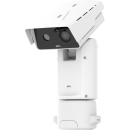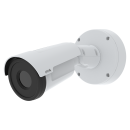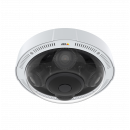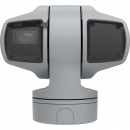
Enhancing Port Security for COANA Compliance
Brasil Terminal Portuário (BTP) upgrades 30% of security cameras with multidirectional and bispectral technology from Axis Communications to enhance efficiency and meet COANA No. 80 rules at the container handling terminal.

Innovation with new standards
In Brazil, in order to operate in seaports, dry ports, and customs centers, companies must comply with standards established by the Federal Revenue Service. COANA Ordinance No. 80 mandates 24/7 video surveillance with front and rear license plate reading. It sets 4MP image quality for container areas and extends storage time to 180 days, outlining operating conditions and minimum technical requirements for video surveillance systems.
The ordinance did not specify the technology upgrades at BTP, which undergo updates every three years. However, it required balancing image resources and storage space due to new requirements. "With COANA No. 80, image storage time doubled from 90 days to 180 days. That meant we would have to double our storage capacity, i.e. practically build a new data center. With the help of Axis Zipstream technology, we were able to do that," says Fábio Carvalho, Head of Security at Brasil Terminal Portuário.
Sailing through Brazil’s largest port
The Port of Santos is the largest in the country for cargo and container handling. BTP’s terminal has an annual handling capacity of 1.5 million TEU (standard unit of measurement for a 20-foot container), covering 4.63 million square feet. Securing this massive site are 460 video surveillance cameras.

"Ports face significant challenges. For instance, the lower part of an operational ship has no light. So, we require cameras that can perform in these conditions," explains Carvalho.
In response, BTP turned to thermal cameras due to their ability to accurately detect people, objects, and incidents despite difficult atmospheric hindrances – such as fog, snow, smoke – and problematic light conditions. Since BTP was the first to employ them at the Port of Santos, thermal cameras prove to be effective tools for observing container handling areas, monitoring vessels in operation, detecting perimeter intrusion, and examining administrative and operational areas.

Thermal and zoom tech leads way
Integrator and Axis partner, Added, invited the BTP security team to the Axis Experience Center in São Paulo to introduce them to a new hybrid technology that they felt could be useful in their operations. Soon after their visit, BTP pioneered the use of AXIS Q87 Bispectral PTZ Camera Series devices in Brazil. The camera provides two video streams, one for thermal detection and another for visual identification, and integrates 32x optical zoom all in a single device. With their thermal vision and zoom capabilities, the bispectral cameras had an immediate impact.

"The bispectral camera is the icing on the cake of this project. The model was installed to cover sensitive areas, such as the power substation and the perimeter, including the outside, which in our case are areas of vegetation and poor public lighting. Another important point is the ability to operate with video analytics, which we use to generate alerts about possible intruders. Imagine 460 cameras in operation, relying on intelligence to draw the operator's attention. This technology speeds up responses to events," explains Fábio Carvalho.
In addition, the project also uses AXIS Q19 Thermal Camera Series units, which when combined with the video analytics become a very precise detection tool used for operators to determine if people or objects are present in a specific area.
Axis equipment has really made a difference. I've been in the security market for 22 years, I'm from the days of analog cameras, and I'm impressed to see how far the standard of technology has come. Congratulations to Axis, which offers cutting-edge technology at a fair price.

4x safety and cost-effectiveness
Another highlight of the project is the multidirectional infrared (IR) panoramic camera. The AXIS P37 Panoramic Camera Series enables seamless monitoring of four distinct areas within the container handling terminal using a single camera, even in challenging lighting conditions. By reducing the number of cameras, BTP successfully adhered to ordinance standards and eradicated blind spots in the area.
"According to COANA No. 80, any blind spot is in violation of the standards, and we have eliminated the shortcoming by replacing cameras with Axis technology. We removed four cameras and started using one device with four channels using the same infrastructure. As a result, you end up using one network point and can view an area four times larger, which greatly improves the project and the cost-benefit in terms of infrastructure," says Carvalho.

Greater depth and less bureaucracy
Fixed cameras have become allies in customs inspection work. The Federal Revenue Service uses AXIS P14 Bullet Camera Series units for their multifunctional, varifocal attributes. Thanks to Axis Lightfinder 2.0, Forensic Wide Dynamic Range (WDR), and OptimizedIR technology, the cameras can check the opening of cargo containers with full clarity and rich detail, even in challenging lighting conditions.
"It’s visualization is magnificent. You can see all the way to the bottom of the container, if a person enters, you can follow what they are doing from start to end. With the Axis fixed cameras, we get greater depth and this has enabled us to use the images for a remote conference. In practice, it means the elimination of bureaucracy and transparency in the process," says the BTP expert.
And when it comes to port terminals, gaining depth is essential. For example, blocks are split at approximately 1148 feet. Therefore, high-capacity fixed cameras are needed for surveillance, as the infrastructures are far apart. In this respect, the AXIS Q62 PTZ Camera Series model, has also proved its worth and is now being used to monitor drivers at the entrance from a considerable distance.

Reliability test
Fábio Carvalho credits Axis technology for BTP’s enhanced security. Not only are the large containers more secure, even the CCOS door has an Axis network video intercom that offers a wide view and discreet camera capable of providing a fisheye field-of-vision for even greater coverage. This one device replaces three other pieces of equipment for video surveillance, two-way communication, and access control integration.
Carvalho concludes, "Every three years we renew our fleet by 30%, but before we buy we go to the market to see what is available in terms of upgrades. This latest transition has been very worthwhile because we have incorporated cameras with excellent technological resources, which help us on a day-to-day basis and have brought more quality to incident management. In future upgrades we can think about standardization."
Products & solutions
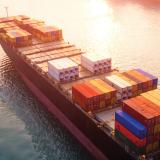
Maritime
Our partner organizations
Get in touch
Want to know how you can benefit from Axis solutions? Get in touch and we will help you.
Contact us